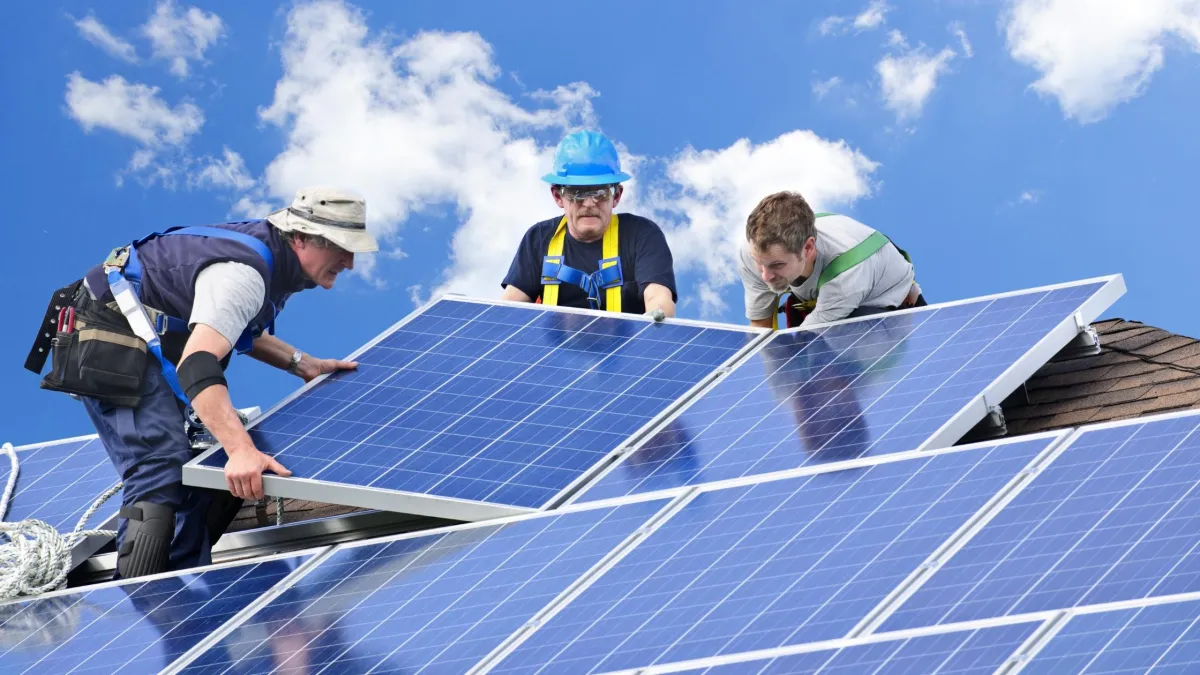Solar & Energy News

Solar Panels vs Tiles: Which Is Right for Your Home?
Choosing the right solar solution for your home is one of the most important decisions you'll make as a property owner. With electricity prices continuing to rise across Queensland, New South Wales, and Western Australia, more Australians are turning to solar energy to reduce their power bills and environmental impact. However, the choice between traditional solar panels and innovative solar tiles can leave many homeowners scratching their heads.
This comprehensive guide examines the key differences between solar panels and tiles, helping you make an informed decision that suits your home's architecture, budget, and energy needs.
Understanding Solar Panels: The Traditional Choice
Solar panels have been the go-to solution for residential solar installations for decades. These rectangular modules typically measure around 1.7 metres by 1 metre and are mounted on aluminium frames that sit above your existing roof structure.
Traditional photovoltaic panels contain silicon cells that convert sunlight into electricity. They're installed using a racking system that creates a small gap between the panels and your roof, allowing airflow underneath to prevent overheating and maintain efficiency.
Most Australian homes use either monocrystalline or polycrystalline solar panels. Monocrystalline panels feature a uniform black appearance and offer slightly higher efficiency, whilst polycrystalline panels have a blue-speckled look and provide excellent value for money.
What Are Solar Tiles?
Solar tiles, also known as solar shingles or photovoltaic tiles, represent a newer approach to residential solar energy. Instead of mounting panels on top of your existing roof, solar tiles replace traditional roofing materials entirely.
These integrated products serve dual purposes: they generate electricity whilst protecting your home from the elements. Solar tiles are designed to blend seamlessly with your roofline, creating a more aesthetically pleasing appearance than traditional panel installations.
The most well-known solar tile product is Tesla's Solar Roof, though several other manufacturers now offer competing products. These tiles typically feature low-profile designs that mimic the appearance of conventional roof tiles, slate, or shingles.
Aesthetic Comparison: Appearance Matters
One of the most significant differences between solar panels and tiles lies in their visual impact on your home's exterior.
Traditional solar panels sit noticeably above your roofline, creating a distinct appearance that clearly signals your commitment to renewable energy. Whilst modern panels look far sleeker than older generations, they remain visible additions to your roof structure.
Solar tiles offer a much more integrated aesthetic. They lie flush with your roofline and can be designed to match your home's architectural style. For heritage homes, modern architectural designs, or properties in areas with strict planning regulations, solar tiles provide an elegant solution that doesn't compromise your home's appearance.
However, this enhanced aesthetic comes with trade-offs that we'll explore in the following sections.
Installation Process and Complexity
The installation process differs dramatically between solar panels and tiles, affecting both the timeline and overall cost of your project.
Solar panel installation is relatively straightforward. Experienced installers can typically complete a residential system in one to three days, depending on the size and complexity. The process involves mounting the racking system to your existing roof, securing the panels, connecting the electrical components, and testing the system.
Your existing roof remains intact during panel installation, meaning there's minimal disruption to your home's weather protection. If problems arise or you need to access your roof for repairs, panels can be removed and reinstalled relatively easily.
Solar tile installation is considerably more complex and time-consuming. Because tiles replace your existing roofing material, installation essentially involves re-roofing your entire home whilst simultaneously creating a solar energy system. This process can take several weeks to complete.
The complexity means fewer installers have the necessary expertise and certification to work with solar tiles. In regional areas of Queensland, New South Wales, and Western Australia, finding qualified solar tile installers can be particularly challenging.
Cost Comparison: Investment Considerations
Budget is often the deciding factor when choosing between solar panels and tiles, and the cost difference is substantial.
Traditional solar panel systems offer excellent value for money. A typical 6.6kW system for an Australian home costs between $4,500 and $9,000 after government rebates, depending on the quality of components and your location. These systems generally pay for themselves within 3-6 years through electricity savings.
Solar tiles represent a significantly larger investment. Depending on your roof size and the product chosen, solar tile installations can cost $30,000 to $70,000 or more. This higher cost reflects both the premium technology and the fact that you're essentially paying for a complete roof replacement alongside your solar system.
However, if you're already planning to replace your roof due to age or damage, solar tiles become more financially attractive. Professional solar consultants like Lux Solar can assess your specific situation and provide accurate cost comparisons that account for your home's unique characteristics and energy requirements across Queensland, NSW, and Western Australia.
The substantial price difference means solar tiles currently appeal primarily to homeowners who prioritise aesthetics, are already replacing their roof, or are building new homes where the incremental cost is less dramatic.
Energy Efficiency and Performance
When it comes to generating electricity, traditional solar panels generally outperform solar tiles in several key areas.
Modern solar panels achieve efficiency ratings between 18% and 22%, with premium models reaching even higher. This means they convert a significant portion of the sunlight hitting them into usable electricity. Their elevated mounting position allows excellent airflow underneath, keeping them cooler and maintaining peak performance even during Australia's hot summers.
Solar tiles typically achieve efficiency ratings between 14% and 18%. The lower efficiency means you'll need more roof space to generate the same amount of electricity as traditional panels. Their flush-mounted design also means less airflow, which can lead to higher operating temperatures and reduced performance during extreme heat.
However, solar tiles do offer one performance advantage: their low profile makes them less susceptible to wind damage, which can be important in cyclone-prone areas of Queensland and Western Australia.
Durability and Warranty Coverage
Both solar panels and tiles are designed to withstand Australian weather conditions, but their warranties and expected lifespans differ.
Quality solar panels typically come with 25-year performance warranties guaranteeing at least 80% of their original output after a quarter-century. Product warranties covering manufacturing defects usually last 10-15 years. With proper maintenance, panels often continue producing electricity for 30-40 years.
Solar tiles are newer technology, so their long-term durability remains less proven. Most manufacturers offer warranties similar to traditional panels, typically 25 years for power output and 10-15 years for the tiles themselves. However, because tiles serve as both your roof and your power source, any issues potentially compromise both functions simultaneously.
Traditional panels benefit from decades of real-world performance data, giving homeowners greater confidence in their longevity and reliability.
Maintenance Requirements
Maintenance needs represent another important consideration when comparing solar panels and tiles.
Solar panels require minimal maintenance beyond periodic cleaning to remove dust, leaves, and bird droppings. Their elevated position makes them relatively easy to inspect and clean. If individual panels fail, they can be replaced without affecting your roof's integrity.
Solar tiles require similar cleaning but present additional challenges. Their integrated design makes individual tile replacement more complex and potentially more expensive. If tiles are damaged by storms or falling branches, repairs may require specialist knowledge and custom-ordered components.
Both systems benefit from annual professional inspections to ensure optimal performance and identify potential issues before they become serious problems.
Suitability for Different Home Types
Your home's characteristics significantly influence which solution works best.
Solar panels suit virtually any home with adequate roof space and suitable orientation. They work equally well on tile, metal, or Colorbond roofs. Their modular nature means systems can be sized precisely to your energy needs and available space.
Solar tiles work best on simple roof designs with large, uninterrupted surfaces. Complex roofs with multiple angles, dormers, or skylights become prohibitively expensive with tile installations. Heritage homes, modern architectural designs, and properties in areas with restrictive covenants often benefit most from tiles' aesthetic advantages.
New home builds present an ideal opportunity for solar tiles, as the complete roofing cost can be integrated into construction financing, making the premium more manageable.
Impact on Property Value
Both solar panels and tiles can increase your property's value, though the impact varies.
Solar panels demonstrably increase home values, with studies showing buyers will pay premiums for homes with existing solar systems. The combination of reduced electricity bills and environmental benefits appeals to many purchasers.
Solar tiles potentially add even more value due to their aesthetic integration, though the market for homes with solar tiles remains smaller simply because they're less common. The perceived value also depends heavily on the buyer's priorities and awareness of the technology.
In competitive property markets across Sydney, Brisbane, and Perth, solar installations of either type represent attractive selling points that can differentiate your home from comparable properties.
Making Your Decision: Key Factors to Consider
Choosing between solar panels and tiles requires honest assessment of your priorities and circumstances.
Choose traditional solar panels if you:
Want the most cost-effective solar solution
Prioritise maximum energy production and efficiency
Need a quick installation with minimal disruption
Have a functional roof that doesn't need replacement
Value proven technology with decades of performance data
Want the flexibility to upgrade or modify your system easily
Choose solar tiles if you:
Prioritise aesthetics and architectural integration
Already need to replace your roof
Live in an area with strict planning regulations
Are building a new home
Have a simple roof design with large, uninterrupted surfaces
Have a larger budget and long-term investment horizon
The Verdict: Which Should You Choose?
For most Australian homeowners, traditional solar panels remain the superior choice. They offer proven performance, excellent value for money, straightforward installation, and easier maintenance. The technology is mature, installers are widely available, and the return on investment is compelling.
Solar tiles represent an innovative alternative that excels in specific circumstances. If you're replacing your roof anyway, building new, or simply cannot compromise on aesthetics, tiles offer a viable solution despite their premium pricing.
The gap between these technologies will likely narrow as solar tiles become more common, manufacturing scales up, and more installers gain relevant expertise. However, for now, traditional panels deliver the best combination of performance, reliability, and affordability for most situations.
Conclusion
Both solar panels and tiles offer legitimate paths to energy independence and reduced electricity bills. Your choice ultimately depends on your budget, aesthetic preferences, home characteristics, and timeline.
The most important step is working with experienced professionals who can assess your specific situation and provide honest guidance. Whether you choose traditional panels or innovative tiles, investing in solar energy represents a smart decision that benefits both your household finances and the environment.
Take time to research thoroughly, obtain multiple quotes, and ask plenty of questions before committing to either solution. Your solar investment will serve your home for decades, making it worth the effort to choose wisely.
Privacy Policy | © 2025 Lux Solar Pty Ltd

